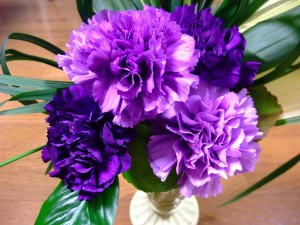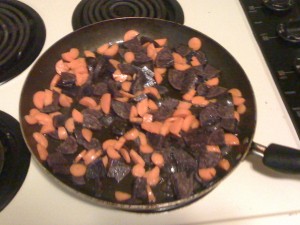
Florigene's Moondust carnations, one of several violet and blue varieties they've created with genetic engineering. Photo by Pagemoral and licensed under the creative commons. Click to see the photo in its original context with license information
Scientific Name: Dianthus caryophyllus
Genetically Engineered Trait: Anthocyanin biosynthesis (blue and violet plant pigments)
Details of Genetic Engineering:
The market in flowers with genetically engineered colors is (to my knowledge) occupied by a single Australian company called Florigene. They study anthocyanins, the class of plant pigments responsible for, among other things, the coloration of purple potatoes, purple carrots, black rice, purple corn, and many blue and purple berries. Anthocyanins are one of the key classes of plant pigments, found to greater or lesser extent in most flowering plants.* Florigene has been producing purple and sometimes blue carnations since the 1990s by adding key enzymes in the anthocyanin pathway from other plant species. While purple carnations are cool, the real goal of Florigene’s work has been blue (and purple, and violet) roses, something rose breeders have been trying and failing to create for centuries.
Florigene was granted a license to grow their first breed of genetically engineered blue rose this summer, (although as far as I can tell the roses aren’t yet for sale, so they don’t get their own post). For more on plant pigments, Florigene, and why the development of blue roses as foiled breeders for so long, check out this fascinating post by MAT Kinase.

Purple potatoes with orange carrots (and did you know most carrots were white when they were first domesticated?)
About Carnations:
Carnations belong to the caryophyllales, an extended family of plants that include cacti (cool), rhubarb (tasty), and carnivorous plants like sundews and venus fly traps(awesome!). Beyond that, I’ll admit I don’t know much about their biology.
If you know someone who is into flower meanings (I used to date a girl who was), you’ll notice there is no definition on record for blue carnations. It makes them the perfect gift to say, “I like you, so I bought you flowers” without having to worry about any unintentional subtext beside: “I’m also a huge plant/genetics geek, and if you don’t ask me soon how they make the flowers blue I’m going to burst!”
*The extent of anthocyanin biosynthesis in flowering plants is a good indicator that the ancestor of all the flowering plants alive today (which lived sometime between 250 and 100 million years ago) already contained the genes needed to produce anthocyanins, and flowering plants which are unable to produce them today, like roses, cannot because their ancestors lost the ability.